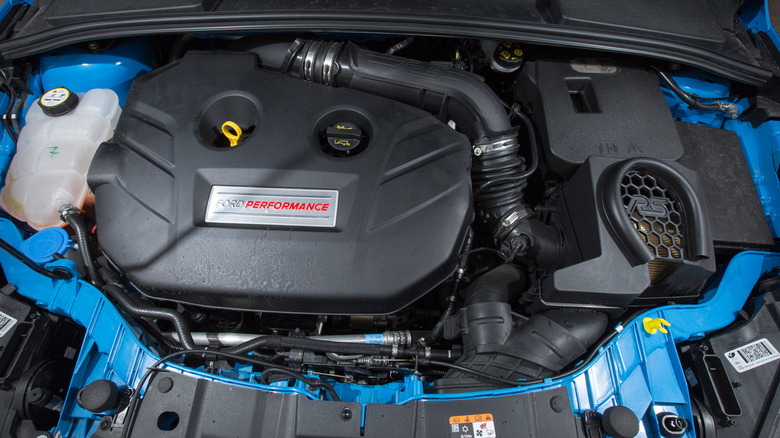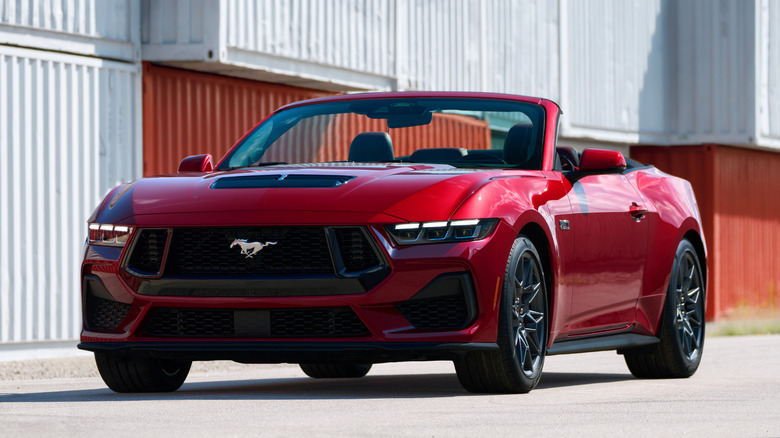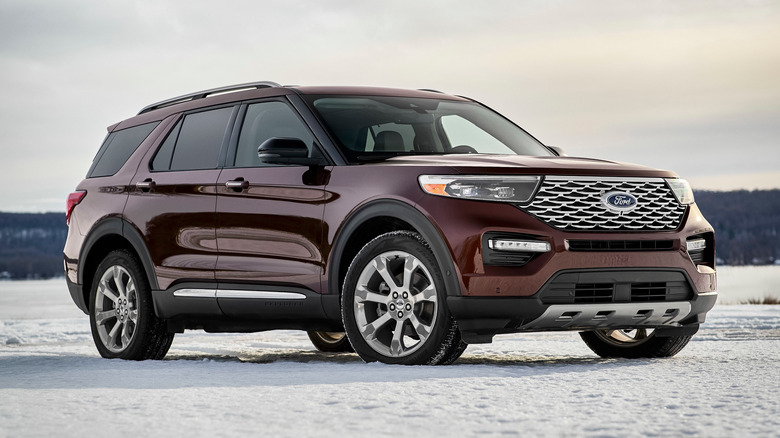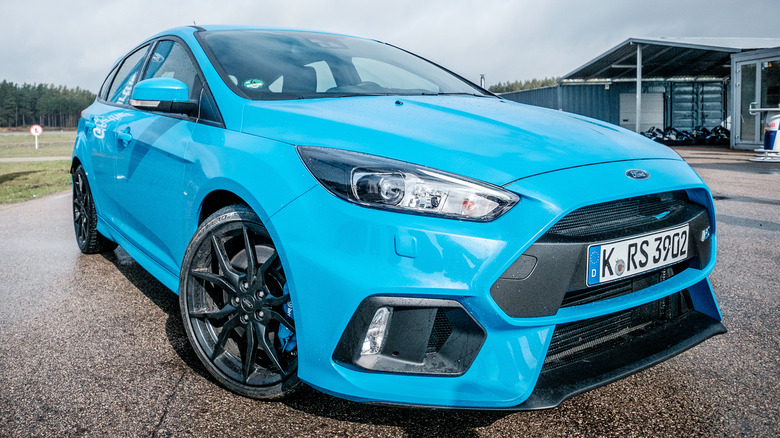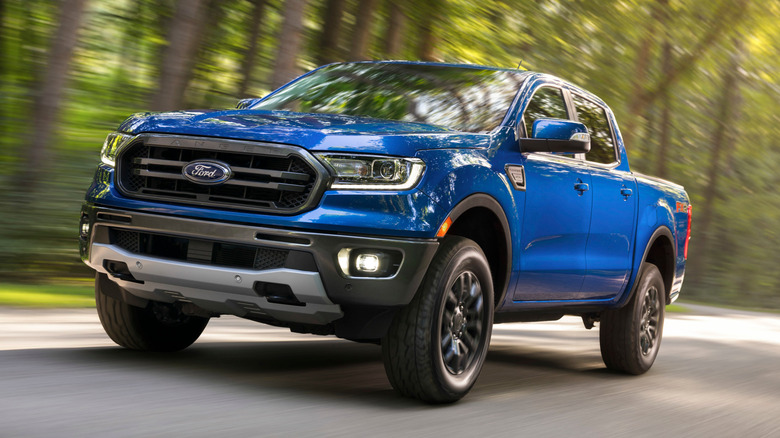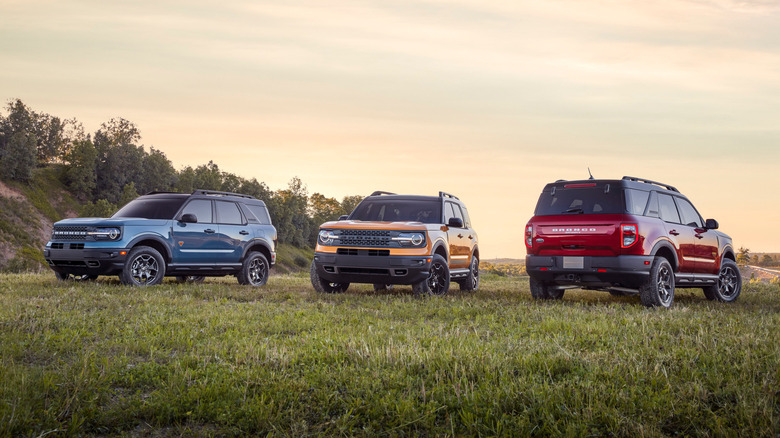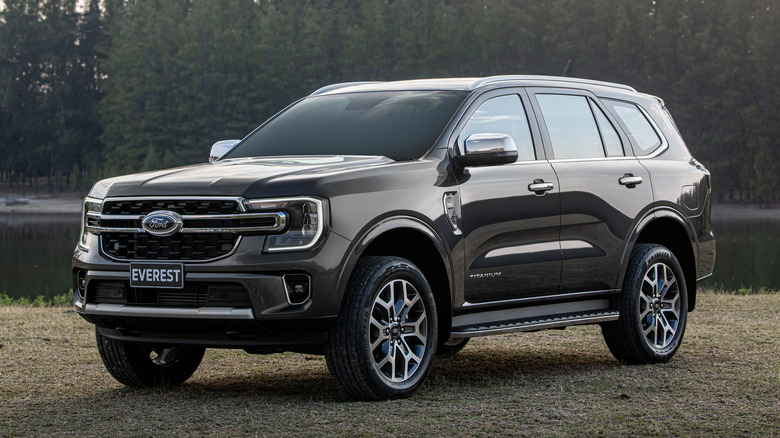Every Ford Model Powered By The 2.3L Ecoboost Engine
Ford Motor Company unveiled the EcoBoost engine at the start of 2008, aiming to improve fuel economy and carbon dioxide emissions across its range of Ford, Lincoln, and Mercury cars. The first-ever EcoBoost was a 355-hp, 3.5-liter, twin-turbo V6 that debuted in the 2009 Lincoln MKS, and Ford quickly followed that up with a 2.0-liter four-cylinder engine in 2011 for vehicles like the Explorer and Mondeo.
However, it took until 2015 for Ford to introduce one of the best EcoBoost engines ever, the twin-scroll turbo-equipped 2.3-liter EcoBoost. Debuting in the 2015 Ford Mustang and Lincoln MKC, the small four-cylinder engine essentially rendered Ford's old 3.7-liter V6 — as seen in the Mustang — irrelevant, with more power and better fuel economy.
The 2.3-liter EcoBoost would go on to power several Ford Motor Company vehicles, including a couple of Lincoln cars — the MKC and Corsair — and some non-Ford cars like the track-oriented VUHL 05RR and Zeneos E10 R. Not surprising, really, given how good the 2.3-liter EcoBoost is at making a lot of power in a small package. It may not have the thrill of a big-displacement engine, but while V8 competitors like the Hemi are being discontinued, the 2.3-liter EcoBoost is alive and well. Ford even introduced an all-new 2.3-liter EcoBoost in the 2024 Mustang, showing that the days of internal combustion engines aren't quite over just yet. Let's look what Ford cars use this small but mighty engine.
Ford Mustang (2015 - present)
Ford's iconic pony car was one of the first cars to receive the 2.3-liter EcoBoost, starting in the 2015 model year. While it offered great power — 310 hp and 320 lb-ft of torque — and better fuel economy than the V6 and V8 options, the tiny four-cylinder wasn't universally loved at first. Contemporary reviews expressed misgivings about the engine note and the relevance of the EcoBoost compared to the V8, which made significantly more power.
Despite the less-than-unanimous praise, Ford stuck to its guns and kept the 2.3 EcoBoost available as an option through the rest of the sixth-gen Mustang's production cycle, outlasting the 3.7-liter V6, which Ford stopped offering in 2018. Ford even introduced an EcoBoost High Performance Package in 2020, which bumped power up to 330 hp and 350 lb-ft of torque and added upgrades such as new 19-inch wheels, improved brakes, tuned chassis and suspension, and a new exhaust — all of which made the EcoBoost Mustang a more engaging drive, albeit allegedly still not quite on par with a proper V8-equipped Mustang.
Ford introduced the seventh-generation Mustang in 2024 with several upgrades and changes, such as a digital dashboard and revised styling. However, the seventh-gen Mustang also got a couple of new engine options: a revised 5.0-liter Coyote V8 and an all-new 2.3-liter EcoBoost. The latter boasts new injection and exhaust recirculation systems and an integrated airbox, resulting in 315 hp and 350 lb-ft of torque. Ford has yet to announce whether other models will get the revised 2.3-liter EcoBoost.
Ford Explorer (2016 - present)
Ford's iconic Explorer SUV — one of the most successful models in the company's history — was one of the earliest nameplates to get the 2.3-liter EcoBoost alongside the Mustang. The four-cylinder turbo powerplant debuted in the engine bay for the 2016 model year as an optional engine alongside two V6 engines, the 3.5-liter EcoBoost V6 and Ford's older non-EcoBoost 3.5-liter V6.
The 2.3-liter EcoBoost replaced the unpopular 2.0-liter EcoBoost, which had been the Explorer's sole EcoBoost engine until then. The 2.3-liter EcoBoost made 280 hp and 310 lb-ft of torque in the Explorer, which was 30 horsepower less than in the Mustang — an early hint at what would become a slightly confusing variety of power numbers across different vehicles. Despite the drop in power compared to the Mustang, reviewers were positive about the new Explorer, with outlets praising the engine's overall performance.
Ford continued offering the 2.3-liter EcoBoost in its 280-hp guise until the 2020 model year, when it introduced a redesigned Explorer. The 2.3-liter EcoBoost, now with auto start-stop technology, got a bump in power to 300 hp and was the standard engine option for the Base, XLT, and Limited 300A trim levels, mated to a 10-speed SelectShift automatic transmission. The 2.3-liter EcoBoost will continue to be the base engine for the 2025 Ford Explorer's Active, ST-Line, and Platinum trim levels, albeit with a standard automatic transmission.
Ford Focus (2016 - present)
If ever a Ford model felt like a perfect match for a 300-hp turbocharged four-banger, it would be the Ford Focus. The long-running hatchback first received Ford's 2.3-liter inline-four engine in 2016, when the company started offering it in the Ford Focus RS. The Focus RS received the most powerful version to make it into a Ford car, with 350 hp and 350 lb-ft of torque. Mated to an advanced all-wheel drive system, the Focus RS had reviewers raving when it debuted on American shores.
Unfortunately, American gearheads only had a couple of years to enjoy the Focus RS. Despite being one of Ford's best-selling vehicles, the company decided to discontinue U.S. production of the entire Focus line — and other passenger cars, barring the Mustang — in 2018, to focus on the more lucrative utility vehicle and pickup truck segments.
Ford Europe brought the engine back for the 2019 Ford Focus ST in Europe, serving as the car's gasoline engine alongside a 2.0-liter diesel. The Focus ST's EcoBoost wasn't quite as powerful as the one in the RS, with only 280 hp and 310 lb-ft of torque, but it was more than enough for contemporary reviewers to praise the ST's power delivery and overall performance.
The 2.3-liter EcoBoost is still available in the Focus ST as of 2024, but not for long: Ford is discontinuing the Focus, with production scheduled to cease in mid-2025.
Ford Ranger (2019 - present)
The Ranger nameplate has a storied history, debuting as a compact pickup truck for the 1983 model year to replace the Mazda-built Ford Courier. The Ranger existed as a compact pickup for nearly three decades, hosting a variety of engines, including a 143-hp 2.3-liter inline-four, before declining sales led to Ford discontinuing it in 2008 and ceasing U.S. production in 2012.
But the Ranger isn't dead: Ford continued building the truck for international markets, debuting an all-new T6 Ranger at the Australian International Motor Show in 2010. After a good few years in the wilderness, Ford eventually brought the now mid-sized pickup back to American shores for the 2019 model year. Announced at 2018's North American Auto Show in Detroit, the Ranger launched with the 2.3-liter EcoBoost as the only engine option. The inline-four made 270 hp and 310 lb-ft of torque in the rebooted pickup truck, mated to a 10-speed SelectShift automatic transmission in all three available trim levels — XL, XLT, and Lariat.
The 2.3-liter EcoBoost, with the same 270-hp power output, has remained the base engine option for all Rangers since. However, it's no longer the only engine option: Starting with the 2024 Ranger, Ford introduced a 315-hp, 400 lb-ft 2.7-liter EcoBoost engine option for the XL, XLT, and Lariat trim levels, as well as a new Ranger Raptor trim level with the same 3.0-liter EcoBoost V6 as the Bronco Raptor, making 405 hp and 430 lb-ft of torque.
Ford Bronco (2021 - present)
The Ranger wasn't the only classic nameplate that Ford would bring back around the turn of the decade. Hot on the heels of the revived American Ranger in 2019, Ford introduced an all-new Bronco to the market for the 2021 model year, 25 years after it discontinued the previous generation. Built on the same T6 architecture as the contemporary Ranger, Ford marketed the new Bronco as an off-road monster, with a dizzying array of trim levels — Base, Big Bend, Black Diamond, Outer Banks, Badlands, Wildtrak, and First Edition — available for its debut year
The trim levels dictated features and equipment such as the engine, terrain management modes, wheels, tires, transmissions, and four-wheel drive systems. Of the seven trim levels, four — Big Bend, Black Diamond, Outer Banks, and Badlands — came with the 2.3-liter EcoBoost inline-four as standard, which made 300 hp and 325 lb-ft of torque in the Bronco, albeit only on premium gasoline. Ford paired the four-cylinder with seven- or 10-speed transmissions, depending on the trim level.
Starting with the 2023 model year, Ford introduced the retro-minded Ford Bronco Heritage and Heritage Limited editions. These sport a two-tone paint job and squared-off fenders, but are otherwise mechanically identical to other Bronco trim levels. The Heritage sports Big Bend equipment, with the 2.3-liter EcoBoost as standard, while the Heritage Limited opts for the Badlands trim's optional 2.7-liter EcoBoost V6. As of 2024, the Bronco is available in eight trim levels, meaning there's a Bronco out there for anyone.
Ford Everest (2020 - present)
Ford introduced the Everest at the Bangkok International Motor Show in 2003 as a seven-seater SUV based on the contemporary Ford Ranger platform. Designed exclusively for Asian markets, the Everest debuted with 2.6-liter gasoline and 2.5-liter diesel engines, later joined by a 3.0-liter Duratorq engine in 2007.
While Ford started offering EcoBoost engines in its American and European cars around 2010, with the 2.3-liter unit we've been taking a look at here debuting in 2015, it wasn't until 2020 that Everest buyers could get a real taste of what made the EcoBoost engine so special. 2020 saw the introduction of the 2.3-liter EcoBoost inline-four for the Chinese market Everest, replacing the 2.0-liter EcoBoost with a more powerful 270-hp, 335 lb-ft engine.
However, it took a couple more years for Everest buyers outside China to get the 2.3-liter EcoBoost as an engine option, with the inline-four selected as the only gasoline engine option for the new-generation Everest in 2022. Power output was once again different, with the engine making 300 hp and 310 lb-ft of torque once it had made its way to the wider Asian market. Add to that features like electronically-controlled four-wheel-drive, driveline and differential locks, and the ability to drive through up to 2.5 feet of water, and it's no surprise that we ranked the Everest as one of the coolest Fords you can't buy in America.
